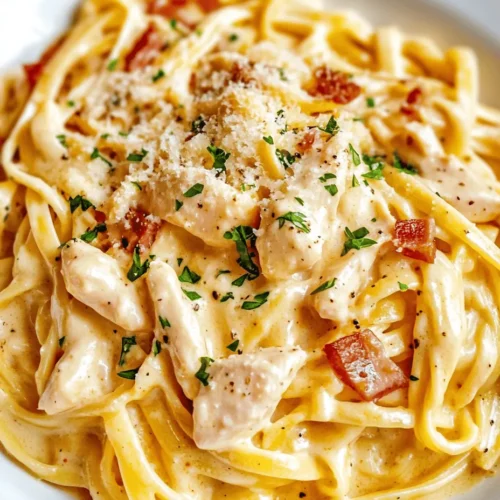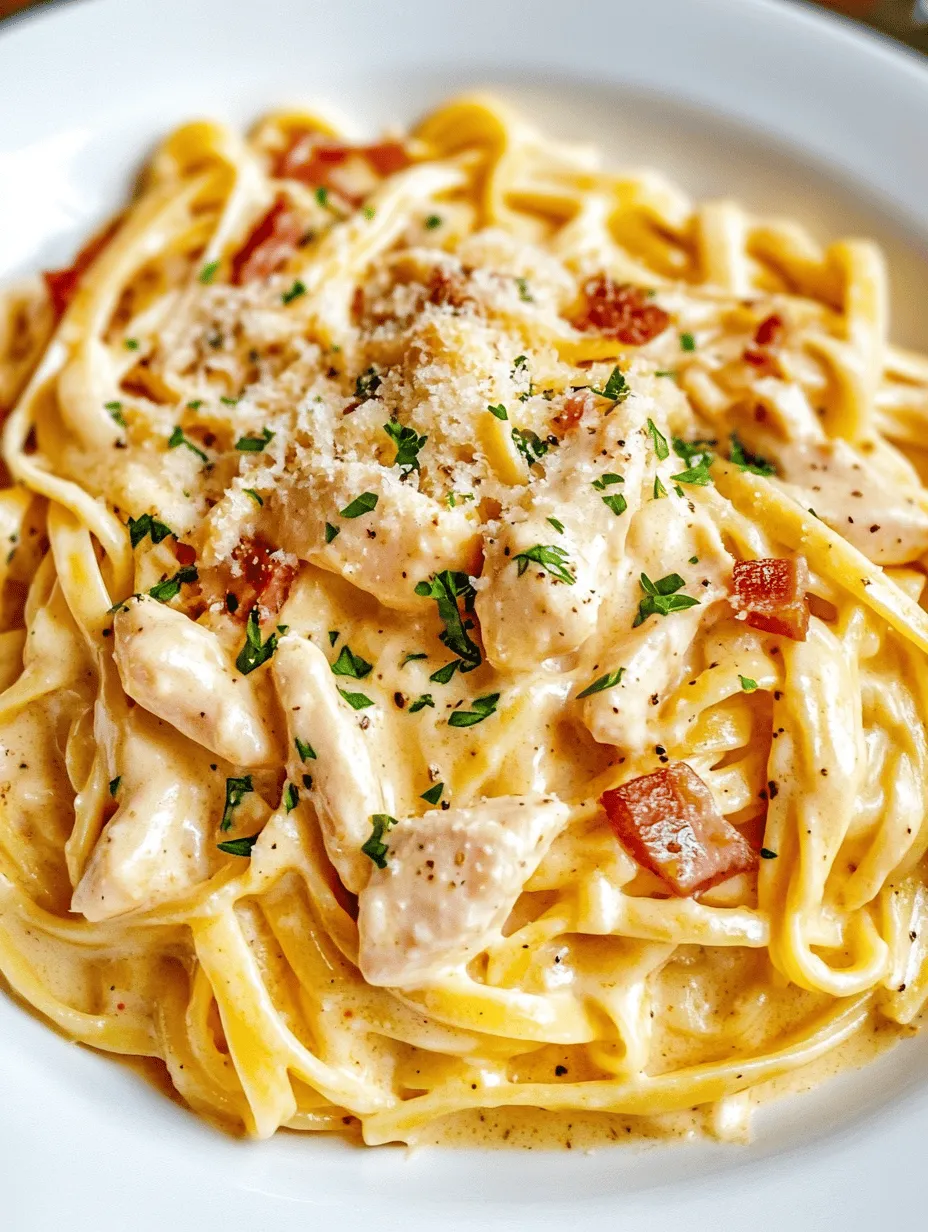Introduction
Chicken Carbonara is a delightful and comforting dish that captures the essence of Italian cuisine while providing a modern twist that many home cooks love to embrace. Originating from the heart of Italy, this creamy pasta dish typically features spaghetti or fettuccine, coated in a luscious sauce made from eggs, cheese, and cured pork. While the classic Carbonara traditionally uses guanciale, the addition of chicken in this recipe makes it a versatile option that is both satisfying and approachable, especially for those who may prefer a lighter protein.
Comfort food holds a special place in our hearts, transcending cultural boundaries and evoking feelings of warmth and nostalgia. It’s no wonder that Chicken Carbonara has found its way into the kitchens of many families around the world. This recipe is perfect for busy weeknights when you want to whip up something delicious without spending hours in the kitchen. With its creamy texture and rich flavors, Chicken Carbonara promises to please everyone at the dinner table.
The Allure of Carbonara
The historical roots of Carbonara are somewhat murky, with various theories about its origins. Some believe the dish was created by Italian charcoal workers, or “carbonari,” in the Apennine Mountains, while others suggest it was invented in Rome, possibly in the mid-20th century. Regardless of its true beginnings, Carbonara has become a staple of Italian cuisine, celebrated for its simplicity and bold flavors.
Traditional Carbonara features a combination of spaghetti, eggs, cheese, and guanciale, which is an Italian cured meat made from pork cheek. The dish relies on the heat of the pasta to cook the eggs gently, creating a creamy sauce that clings to the noodles. However, as culinary preferences have evolved, variations of Carbonara have emerged, including the widely popular Chicken Carbonara.
This version swaps out the guanciale for chicken, making it a protein-rich option that is still packed with flavor. The addition of chicken not only adds a satisfying element but also makes the dish more accessible for those who may not have guanciale on hand. Chicken Carbonara has carved its own niche, offering a delightful compromise that appeals to both traditionalists and modern cooks alike.
Understanding the Ingredients
To create the best-ever Chicken Carbonara, it’s essential to understand the key ingredients that contribute to the dish’s incredible flavor and creamy texture. The following components play a pivotal role in making this dish a standout:
Pasta: Fettuccine or Spaghetti?
The choice of pasta can greatly influence the overall experience of the dish. While traditional Carbonara is typically made with spaghetti, fettuccine is a popular alternative that lends a thicker, more substantial feel to the dish. Both options work well, so choose your favorite or whatever you have available in your pantry. The important thing is to ensure that the pasta is cooked al dente — firm to the bite — to create the ideal texture that will hold the sauce.
Chicken Breasts
For this recipe, boneless, skinless chicken breasts are preferred due to their lean nature and quick cooking time. Chicken breasts absorb flavors beautifully, making them a great canvas for the rich sauce. When cooked properly, they remain juicy and tender, enhancing the overall enjoyment of the dish.
Pancetta vs. Guanciale
While traditional Carbonara calls for guanciale, pancetta serves as a delicious substitute in Chicken Carbonara. Pancetta is an Italian cured pork that offers a similar flavor profile but is more readily available in most grocery stores. The main difference lies in the cut of meat; pancetta comes from the pork belly, whereas guanciale comes from the cheek. Both types of meat add a savory depth to the dish, but pancetta tends to be slightly sweeter. Whichever you choose, aim for high-quality, unsmoked options for the best flavor.
Eggs, Cheese, and Cream
The combination of eggs, cheese, and cream is what makes Carbonara truly indulgent. Traditionally, Carbonara uses Pecorino Romano cheese, known for its sharp, salty flavor. This cheese, when combined with eggs, emulsifies into a creamy sauce that beautifully coats the pasta. In Chicken Carbonara, you can also incorporate a bit of Parmesan for added richness.
While some recipes call for heavy cream, true Carbonara relies on the creaminess of the eggs and cheese alone. However, if you’re looking for a slightly richer sauce, a splash of cream can help achieve that velvety texture without compromising the dish’s integrity.
Garlic and Seasoning
A touch of garlic can elevate the flavor of Chicken Carbonara, adding depth and aroma. Be sure to sauté the garlic gently to release its natural oils without browning it, which can lead to bitterness. Seasoning is also crucial; a pinch of salt and freshly cracked black pepper will enhance the flavors of the chicken and pasta, creating a well-rounded dish.
Selecting High-Quality Ingredients
The secret to a truly memorable Chicken Carbonara lies in the quality of the ingredients. Fresh, high-quality pasta, organic chicken, and artisanal cheeses will significantly impact the final outcome. When shopping for ingredients, consider visiting local markets or specialty stores to find the best options. Using fresh ingredients not only enhances the flavor but also makes the cooking process more enjoyable.
Step-by-Step Cooking Instructions
Now that we’ve covered the essential components of Chicken Carbonara, let’s dive into the detailed cooking instructions to guide you through the process of creating this delectable dish.
Cooking the Pasta
1. Start by bringing a large pot of salted water to a rolling boil. The salt is key to flavoring the pasta as it cooks.
2. Once boiling, add your choice of fettuccine or spaghetti and cook according to package instructions until al dente. Be sure to taste the pasta a minute or two before the suggested cooking time to ensure it’s cooked to your liking.
3. Before draining the pasta, reserve about a cup of the pasta cooking water. This starchy water is an essential component in adjusting the sauce’s consistency.
4. Drain the pasta and set it aside, keeping it warm while you prepare the chicken.
Preparing the Chicken
1. While the pasta is cooking, season the boneless, skinless chicken breasts with salt and freshly cracked black pepper. You can also add a pinch of garlic powder for extra flavor if desired.
2. Heat a large skillet over medium-high heat and add a tablespoon of olive oil. Once hot, carefully place the chicken breasts in the skillet.
3. Cook the chicken for about 6-7 minutes on each side, or until golden brown and cooked through. Use a meat thermometer to check that the internal temperature reaches 165°F (75°C). Once done, remove the chicken from the skillet and let it rest for a few minutes before slicing it into thin strips.
Cooking the Pancetta
1. In the same skillet used for the chicken, add the pancetta over medium heat. Cook until it becomes crispy, about 4-5 minutes. Stir occasionally to ensure even cooking.
2. Once the pancetta is browned and crispy, add minced garlic to the skillet and cook for an additional 30 seconds, just until fragrant. Be careful not to let the garlic burn.
In the next section of this article, we will delve deeper into combining the ingredients to create that signature creamy sauce and finishing the Chicken Carbonara to perfection. Stay tuned for the continuation of this flavorful journey!

Making the Sauce: Techniques for Whisking Eggs and Cream to Avoid Curdling
Creating the perfect sauce for Chicken Carbonara requires precision and care, particularly when it comes to whisking the eggs and cream. The goal is to achieve a smooth, creamy consistency without allowing the eggs to scramble. Here are some techniques to ensure your sauce remains velvety:
1. Temperature Control: Begin by allowing your ingredients to reach room temperature. Cold eggs or cream added to hot pasta can lead to curdling. If you’ve just cooked your pasta, let it sit for a minute while you prepare the sauce.
2. Whisking Method: In a mixing bowl, combine the eggs and heavy cream. Use a whisk to blend them thoroughly until the mixture is uniform. This aeration helps create a lighter sauce. You can also add grated Parmesan cheese at this stage for added flavor.
3. Tempering the Eggs: To prevent the eggs from scrambling, you can temper them. Slowly add a small amount of the hot pasta water (about 1/4 cup) to the egg mixture while whisking continuously. This process gradually raises the temperature of the eggs, reducing the risk of curdling.
4. Combining with Pasta: Once you have your pasta ready, remove it from the heat. Immediately add the egg and cream mixture, tossing quickly to coat the pasta evenly. The heat from the pasta will gently cook the eggs, creating a creamy sauce.
Combining the Ingredients: Tips for Achieving the Perfect Creamy Consistency
Achieving that luxurious, creamy consistency in Chicken Carbonara is all about timing and technique. Here are some tips to guide you through this essential step:
1. Quick Tossing: As soon as you add the sauce to the pasta, use tongs or a pasta fork to toss the mixture vigorously. The residual heat from the pasta will help thicken the sauce without cooking the eggs too much.
2. Adjusting Consistency: If the sauce appears too thick, add a little more reserved pasta water, a tablespoon at a time, until you reach your desired creaminess. This starchy water not only helps thin out the sauce but also enhances its flavor.
3. Final Seasoning: Before serving, taste your Carbonara and adjust the seasoning with freshly cracked black pepper and additional cheese if needed. The balance of flavors at this stage is crucial for a satisfying dish.
Nutritional Breakdown
Understanding the nutritional content of your Chicken Carbonara can enhance your dining experience, allowing you to appreciate each bite while maintaining a balanced diet.
– Caloric Content: A typical serving of Chicken Carbonara (approximately 1 cup) contains around 600-700 calories. This may vary based on the amount of cream and cheese used.
– Macronutrient Breakdown:
– Protein: 30-35 grams, primarily from the chicken and eggs.
– Carbohydrates: 50-60 grams, mainly from the pasta.
– Fat: 25-30 grams, coming from the cream and cheese.
– Indulgence vs. Nutrition: While Chicken Carbonara is undeniably indulgent, it provides a good source of protein and can be part of a balanced meal. However, if you’re watching your calorie intake, consider reducing the amount of cream and cheese or using alternatives.
– Suggestions for Lighter Alternatives:
– Whole Wheat Pasta: Swap regular pasta for whole wheat or legume-based options for added fiber and nutrients.
– Reduced-Fat Dairy: Use half-and-half or low-fat cream instead of heavy cream.
– Vegetable Additions: Introduce spinach, peas, or mushrooms to enhance nutritional value without significantly increasing calories.
Serving Suggestions
To elevate your Chicken Carbonara experience, consider these serving suggestions that complement the dish beautifully:
1. Ideal Accompaniments: Pair your Carbonara with a fresh arugula salad dressed with lemon vinaigrette. The peppery greens balance the richness of the pasta.
2. Recommended Side Dishes: Serve with garlic bread or a side of roasted or sautéed vegetables like asparagus or broccoli for a well-rounded meal.
3. Wine Pairings: The creamy texture of Chicken Carbonara pairs well with a crisp white wine, such as a Pinot Grigio or a light Chardonnay. If you prefer red, a light-bodied option like a Chianti can also complement the flavors.
4. Presentation Tips: For an appealing presentation, twirl the pasta into nests on each plate, garnishing with freshly chopped parsley and a sprinkle of extra Parmesan. This adds color and invites your guests to dig in.
Culinary Variations and Customizations
Chicken Carbonara is a versatile dish, inviting a range of variations and personal touches:
1. Exploring Variations: Don’t hesitate to play with the traditional recipe. Adding vegetables like sautéed spinach or peas can introduce new flavors and nutrients. Mushrooms can offer an earthy depth that pairs beautifully with the creamy sauce.
2. Alternative Proteins: For those seeking variety, consider substituting chicken with shrimp, turkey, or even tofu for a vegetarian option. Each protein will bring its own flavor dynamics to the dish.
3. Creating a Spicy Version: If you enjoy a kick, incorporate red pepper flakes or a dash of hot sauce into the sauce. You can also experiment with different cheeses, such as Pecorino Romano, to add a sharper taste.
4. Encouraging Creativity: The beauty of Chicken Carbonara lies in its adaptability. Encourage experimentation with flavors and ingredients to suit your taste preferences. Whether you want to make it lighter, spicier, or packed with veggies, the possibilities are endless.
Conclusion
Making Chicken Carbonara is not merely about cooking a meal; it’s about creating an experience filled with joy and satisfaction. The process of whisking the sauce to a perfect consistency, combining ingredients with care, and serving it beautifully can bring family and friends together around the table. As you prepare this delicious dish, take time to enjoy the aromas, flavors, and the love that goes into each step.
We encourage you to try this Chicken Carbonara recipe and make it your own. Whether you stick to the classic or venture into new culinary territories, this dish promises to be a delightful addition to your dining repertoire. Happy cooking!



